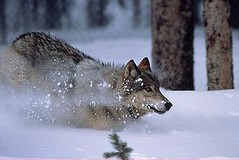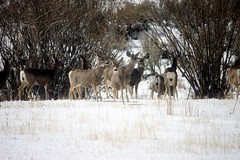 新調查顯示,整個北半球由於大型食肉動物數量減少,已經導致麋鹿、鹿及其他大型草食動物的族群量遠超過歷史紀錄,並危及整個生態系統。這現象以狼的減少最為嚴重。
新調查顯示,整個北半球由於大型食肉動物數量減少,已經導致麋鹿、鹿及其他大型草食動物的族群量遠超過歷史紀錄,並危及整個生態系統。這現象以狼的減少最為嚴重。
「由保育需求來看,保護及復育大型食肉動物可維持整個北部森林生態系的韌性。特別是在面臨急遽的氣候變遷問題時。」奧勒岡州立大學的調查者如此表示。
「這些問題不只影響美國本土及一些國家公園,從加拿大、阿拉斯加、育空、北歐及亞洲等地區取得的資料也顯示了類似的結果。」奧勒岡州立大學調查計畫主持人William Ripple教授指出,「持續的證據顯示了大型食肉動物控制了大型草食動物的族群量,因而維護了健康的生態系。」
回顧過去50年進行的42項研究後,科學家發現沒有狼群的地區,草食動物的密度約是有狼群地區的6倍。
 研究團隊認為,麋鹿、鹿及其他大型草食動物族群量的增加造成樹苗的生長的壓力、且降低生物多樣性。這可能會導致了森林固碳作用降低,及影響氣候變遷。
研究團隊認為,麋鹿、鹿及其他大型草食動物族群量的增加造成樹苗的生長的壓力、且降低生物多樣性。這可能會導致了森林固碳作用降低,及影響氣候變遷。
本研究呈現了大型食肉動物對生態系統的潛在正面效益。大型捕食者藉由對草食動物的族群量控制,提升原生植群的小苗存活率、降低河岸侵蝕、而保護了森林、溪流、其他生物的健康狀態。
研究人員也發現,由狼和熊等不同的大型捕食者的組合,更能有效的維持草食動物的族群量。
「狼群獵殺的動物可成為熊的食物來源,間接維持了熊的族群量。」同樣來自奧勒岡州立大學、本計畫的協同研究者Robert Beschta教授說道,「熊通常會捕食麋鹿、鹿及馴鹿等草食動物的幼獸。在黃石公園的研究呈現被熊補食的小馴鹿,比由狼、郊狼和美洲豹所補食的總和還要多。」
在歐洲的研究呈現,鹿的族群密度在同時有狼和山貓的地方比僅有狼群的地方來的低。
上述研究9日發表於《歐洲野生動物研究》期刊(European Journal of Wildlife Research)。
 奧勒岡州立大學研究團隊致力於瞭解天敵如何抑制草食動物族群改善生態系統、甚至改變草食動物的行為模式。
奧勒岡州立大學研究團隊致力於瞭解天敵如何抑制草食動物族群改善生態系統、甚至改變草食動物的行為模式。
Beschta表示,「在有大型捕食動物的生態系中,他們扮演了維護多樣性及原生植群生產力的主要角色,這個過程讓生態系統更健全。當管理者重新思考獵食者的角色,或許會改變他們目前對野生動物的經營管理模式。」
本研究亦認為,人類打獵無法有效維持大型草食動物的密度,「畢竟人們打獵並不像狼或其他動物般,是在大範圍內的活動。」
「這些結果不僅有助於思考大型食肉動物的經營管理,且適用於大型草食動物及植群上。」
Ripple指出,「我們必須做更多的研究來瞭解要經營一個生態系,多少狼的數量是足夠的。在看到明確的結果前,我們可能必須維持狼的有效族群量。」
Across the Northern Hemisphere, populations of moose, deer, and other large herbivores now far exceed their historic levels and are disrupting ecosystems, finds a new survey on the loss of large predators, particularly wolves.
"The preservation or recovery of large predators may represent an important conservation need for helping to maintain the resiliency of northern forest ecosystems, especially in the face of a rapidly changing climate," conclude the survey authors from Oregon State University.
"These issues do not just affect the United States and a few national parks," said William Ripple, an Oregon State University professor of forestry and lead author of the study. "The data from Canada, Alaska, the Yukon, Northern Europe and Asia are all showing similar results."
"There's consistent evidence that large predators help keep populations of large herbivores in check, with positive effects on ecosystem health," said Ripple.
After examining 42 studies conducted over the past 50 years, the scientists found that herbivore densities are nearly six times greater in areas without wolves as compared to areas with wolves.
The increased populations of moose, deer and other herbivores are crippling the growth of young trees and reducing biodiversity, the Oregon State study concludes. This contributes to deforestation and results in less carbon sequestration, a potential concern with climate change, the researchers said.
Large predators can help maintain native plant communities by keeping large herbivore densities in check, allowing small trees to survive and grow, reducing stream bank erosion, and contributing to the health of forests, streams, fisheries and other wildlife.
The new analysis makes clear that the potential beneficial ecosystem effects of large predators is far more pervasive, over much larger areas, than has been appreciated.
The research results apply to Idaho and Montana, where hundreds of wolves are being killed to reduce ranching conflicts and increase game herd levels, but they apply across the entire Northern Hemisphere as well.
The researchers also found that combinations of predators, such as wolves and bears, "can create an important synergy for moderating the size of large herbivore populations."
"Wolves can provide food that bears scavenge, helping to maintain a healthy bear population," said Robert Beschta, a professor emeritus at Oregon State and co-author of the study. "The bears then often prey on young moose, deer or elk - inYellowstone more young elk calves are killed by bears than by wolves, coyotes and cougars combined."
In Europe, the coexistence of wolves with lynx has also resulted in lower deer densities than when wolves existed alone.
This research survey was published online today in the "European Journal of Wildlife Research."
Oregon State researchers focused on understanding how major predators help to reduce herbivore population levels, improve ecosystem function and even change how herbivores behave when they feel threatened by predation - an aspect they call the "ecology of fear."
"In systems where large predators remain, they appear to have a major role in sustaining the diversity and productivity of native plant communities, thus maintaining healthy ecosystems," said Beschta. "When the role of major predators is more fully appreciated, it may allow managers to reconsider some of their assumptions about the management of wildlife."
The survey concludes that human hunting is not effective in preventing hyper-abundant densities of large herbivores, "because hunting by humans is often not functionally equivalent to predation by large, wide-ranging carnivores such as wolves."
"These findings have important conservation implications involving not only the management of large carnivores, but also that of large herbivores and plant communities," the authors write.
"More studies are necessary to understand how many wolves are needed in managed ecosystems," Ripple said. "It is likely that wolves need to be maintained at sufficient densities before we see their resulting effects on ecosystems."




